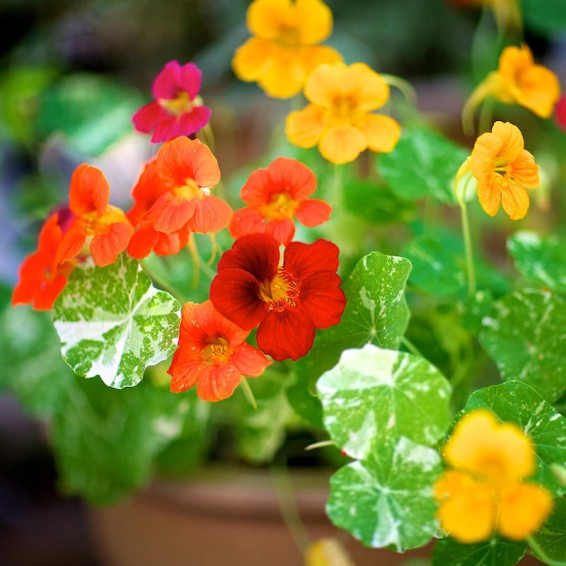Alaska Nasturtium Seed Mix
- HOW TO GROW
- FAST FACTS
- REVIEWS
HOW TO GROW
Sowing: To soften the hard coating on these seeds, rub one side of each seed lightly with sandpaper and soak them in warm water overnight. Mix the seeds with moist sand and store in the refrigerator for 30 days before planting. Sow the seed in early spring, planting just below the surface of the soil. Keep the soil lightly moist until germination, which usually takes place within 7-14 days.
Growing: Water seedlings regularly until they become established. Though they flourish with occasional watering in especially dry weather, mature plants tolerate some drought in addition to growing in poor or sandy soil. Avoid fertilizing, since this tends to produce abundant foliage and few blooms. Deadhead to prolong blooming. This plant may self-seed, and attracts bees. It performs well as a container plant.
Harvesting: Though these blossoms do not last long as cut flowers, the entire plant is edible. Young leaves make excellent fresh greens, while the blossoms are often used as a garnish.
Seed Saving: After the flowers fade, the round seeds will develop in pairs in the dried flower head. Gather them as soon as they easily come loose from the stem. Spread the seed out to dry completely. Store the seed in a cool, dry place.
FAST FACTS
Latin Name: Tropaeolum nanum
Species Origin: Introduced US Flower
Type: Garden Flowers
Life Cycle: Annual, Tender Perennial
USDA Zones: 1, 2, 3, 4, 5, 6, 7, 8, 9, 10, 11, 12
US Regions: California, Mountain, Arid/Desert, Plains/Texas, Midwest, Northern, Northeast, Southeast
Seeds per Ounce: 220
Stratification: No Stratification
Germination Ease: No Stratification
Sunlight: Full Sun
Height: 12 Inches
Color: Mixed, Red, Orange, Yellow
Bloom Season: Blooms Late Summer, Blooms Early Fall
Huntington Beach Public Library Seed Library
The seeds arrived in a very timely manner. We are looking forward to adding this selection to our seed library.
Excited and ready to plant
My seed arrived quickly and I'm eager to get them in the ground. I'm happy with my purchase.
Love nasturtiums
This seed packet promises lovely, sunny, bunches of flowers.
Alaska Nasturtium
My alaska Nasturtiums in 2020 were elegantly beautiful! I adored the varigated leaves and the color of the flowers was delightful! Plants were very healthy and germination was great!
Variegated Leaves
Since I am enamored with variegation in leaves I will be looking forward to what I can do with these seeds in 2021.
very hardy seeds
Love thes Nasturtiums
It's not time to plant yet, but I've ordered from Everwilde before & they grew beautifully.
seeds
I received my package and very happy.
My grandkids are happy too.
nasturtium
Have not arrived yet.
DESCRIPTION
HOW TO GROW
Sowing: To soften the hard coating on these seeds, rub one side of each seed lightly with sandpaper and soak them in warm water overnight. Mix the seeds with moist sand and store in the refrigerator for 30 days before planting. Sow the seed in early spring, planting just below the surface of the soil. Keep the soil lightly moist until germination, which usually takes place within 7-14 days.
Growing: Water seedlings regularly until they become established. Though they flourish with occasional watering in especially dry weather, mature plants tolerate some drought in addition to growing in poor or sandy soil. Avoid fertilizing, since this tends to produce abundant foliage and few blooms. Deadhead to prolong blooming. This plant may self-seed, and attracts bees. It performs well as a container plant.
Harvesting: Though these blossoms do not last long as cut flowers, the entire plant is edible. Young leaves make excellent fresh greens, while the blossoms are often used as a garnish.
Seed Saving: After the flowers fade, the round seeds will develop in pairs in the dried flower head. Gather them as soon as they easily come loose from the stem. Spread the seed out to dry completely. Store the seed in a cool, dry place.
FAST FACTS
Latin Name: Tropaeolum nanum
Species Origin: Introduced US Flower
Type: Garden Flowers
Life Cycle: Annual, Tender Perennial
USDA Zones: 1, 2, 3, 4, 5, 6, 7, 8, 9, 10, 11, 12
US Regions: California, Mountain, Arid/Desert, Plains/Texas, Midwest, Northern, Northeast, Southeast
Seeds per Ounce: 220
Stratification: No Stratification
Germination Ease: No Stratification
Sunlight: Full Sun
Height: 12 Inches
Color: Mixed, Red, Orange, Yellow
Bloom Season: Blooms Late Summer, Blooms Early Fall
Reviews
Review
Huntington Beach Public Library Seed Library
The seeds arrived in a very timely manner. We are looking forward to adding this selection to our seed library.
Review
Excited and ready to plant
My seed arrived quickly and I'm eager to get them in the ground. I'm happy with my purchase.
Review
Love nasturtiums
This seed packet promises lovely, sunny, bunches of flowers.
Review
Alaska Nasturtium
My alaska Nasturtiums in 2020 were elegantly beautiful! I adored the varigated leaves and the color of the flowers was delightful! Plants were very healthy and germination was great!
Review
Variegated Leaves
Since I am enamored with variegation in leaves I will be looking forward to what I can do with these seeds in 2021.
Review
very hardy seeds
Review
Love thes Nasturtiums
It's not time to plant yet, but I've ordered from Everwilde before & they grew beautifully.
Review
seeds
I received my package and very happy.
My grandkids are happy too.
Review
nasturtium
Have not arrived yet.





